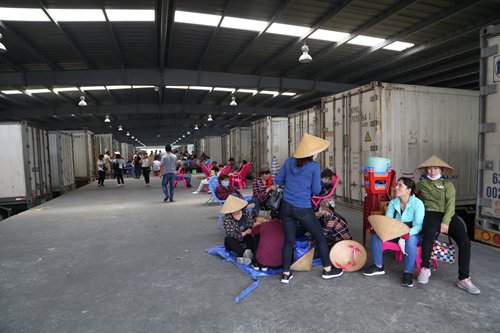
Vietnamese workers wait in an inspection zone in Pingxiang, South China's Guangxi Zhuang Autonomous Region, Thursday. Photo: Chen Qingqing/GT

Tran Van Deo from Tinh Lai Chau, a province in the northwestern region of Vietnam, heads to an employment agency in Pingxiang to get his paperwork approved for a Chinese work visa.
"This is my second time applying for a work visa in China… I live a poor life in my hometown and it's very hard to earn money there," Deo told the Global Times.
With the prospect of making more money to secure a better life, the 23-year-old Vietnamese man was motivated to travel about 360 kilometers to the small Chinese city, which sits along the China-Vietnam border in South China's Guangxi Zhuang Autonomous Region. He now happily works as a logger cutting down trees in mountainous areas nearby.
"If I worked very hard back in my hometown in Vietnam, I would make about 5 million to 6 million Vietnamese dong per month, which is roughly 1,700 to 1,800 yuan [$267.9 to $283.6], and this is the highest salary level there. Here in China, I can make about 3,000 yuan per month," he said.
Pingxiang, a town adjacent to the Vietnamese town of Dong Dang just across the border, has been witnessing an inflow of Vietnamese workers over the past few years thanks to the boom in border trade. And some Chinese and Vietnamese towns near the border areas even share some dialects.
However, many Vietnamese who come to China to work illegally have also exacerbated issues such as drug dealing and human trafficking within the border town, noted a local resident who prefers not to be identified.
"Many Vietnamese workers have day jobs in the town, and go back to Vietnam at night, with some illegal activities usually taking place in remote and mountainous areas," he said.
In Pingxiang, anti-drug campaign slogans are displayed in the streets, and hotels also distribute brochures to advise guests on how to protect themselves from catching HIV/AIDS, which is more common in regions near Asia's Golden Triangle drug hotspot.
The Golden Triangle is the area where the borders of Thailand, Laos and Myanmar meet at the confluence of the Ruak and Mekong Rivers.
"Also, some illegal immigrants carry guns with them, which poses a danger to Chinese society," the anonymous source said.
To clamp down on illegal workers, the town launched a border workforce cooperation scheme in mid-2017, noted Zhang Tianjun, deputy director of the Bureau of Human Resources and Social Security in Pingxiang.
"Local labor-intensive industries such as mahogany furniture and sugar production are all facing shrinking local labor forces, but Vietnamese workers can help fill this gap," Zhang said.
Legalized workforce
In February 2017, the Guangxi regional government approved Pingxiang and another border city called Dongxing as pilot places to carry out the workforce scheme designed to tackle the shortage of labor in border areas.
Pingxiang has also set up a cross-border workforce management center to help streamline visa application processes, covering health checkups, entries and exits as well as insurance.
After factories that need workers report their requests to the local employment agencies, representatives from those agencies begin recruiting suitable workers and helping them get their paperwork ready for the work visa application process.
On a regular Thursday morning, hundreds of Vietnamese workers wait in the workforce management center. When their employment agency representatives finish registering them with customs, the police, the exit-entry administration and insurance agencies, the Vietnamese workers are assigned to different factories based on their skills and experience.
"In order to build strong cooperation and trust among all of these authorities, we screen out some workers who have a criminal background," said Zhang.
The average monthly salary for a Vietnamese worker is about 2,200 yuan to 2,800 yuan, which is about 10 percent lower than their Chinese counterparts, he noted.
When the scheme took effect in mid-2017, "work visas became effective for 30 days, and now we're trying to expand it to 180 days," Zhang said.
On average, the cross-border workforce management center approves about 500 work visas every day for Vietnamese people. "The number surged to around 5,000 to 6,000 shortly after the Chinese New Year - a peak recruitment period… One day, we saw about 8,854 Vietnamese workers arriving in Pingxiang," he said.
The increasing number of Vietnamese workers in the border town also reflects the rising demand for manpower in labor-intensive industries, especially as local authorities have been working on several projects to expand the cargo-handling capacity of the Pingxiang land port.
Growing appetite
In a border inspection zone four kilometers away from the Pingxiang Friendship Gate - a gateway to Vietnam - dozens of Vietnamese women are busy unloading onions in bags from trucks, which would later be transported to Vietnam. Some have already finished their day of work and sit on the other side of the zone, counting the money they have made.
"They all come from Vietnam, about 500 workers every day," said Lin Quan, a manager in the zone.
But the thriving border trade between China and Vietnam has beefed up traffic jams at the border area.
Thankfully, local authorities have been on a mission to expand cargo inspection zones since 2012, with results being realized in 2016.
That year, Pingxiang port recorded a fruit trade volume of 2.04 million tons, accounting for one-quarter of the total volume in China, according to the Chinese Ministry of Commerce. Pingxiang has also remained the largest import-export fruit market in China for the fifth consecutive year.
As more vegetables are shipped from China to Vietnam, traders at the border have also hired Vietnamese workers to unload and upload cargos. "We import about 1,500 TEUs [twenty-foot equivalent units] of watermelon, 1,000 TEUs of litchi and hundreds of TEUs of dragonfruit every year from Vietnam, and annual growth is estimated to reach 20 to 30 percent [this year]," said Chen Huiyun, manager at trading company Xingyi.
"Sometimes, we hire more than 10 Vietnamese workers. Compared to Chinese workers, Vietnamese workers have turned out to be more hard-working and have team-building spirits. Also, they have little requests for their employers in terms of salary and accommodation," Chen said.
Work in China has become a trendy thing in Vietnam, noted Deo. "Coming to work here to earn more money, for a better life, is widely spoken about where I come from," he said.

